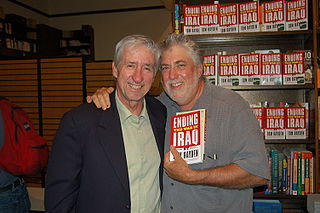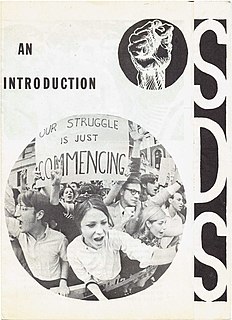
The Weather Underground was a radical left wing militant organization first active in 1969, founded on the Ann Arbor campus of the University of Michigan. Originally known as the Weathermen, the group was organized as a faction of Students for a Democratic Society (SDS) national leadership. Officially known as the Weather Underground Organization (WUO) beginning in 1970, the group's express political goal was to create a revolutionary party to overthrow American imperialism.
David Gilbert is an American far-left activist who participated in the deadly 1981 robbery of a Brinks armored vehicle. Gilbert was a founding member of the Columbia University chapter of Students for a Democratic Society and became a member of the Weather Underground. Gilbert, who served as the getaway driver in the robbery, was convicted under New York’s felony murder law in the killing by co-defendants of two Nyack, New York police officers and a Brink's security guard.

Bernardine Rae Dohrn is a retired law professor and a former leader of the left-wing radical group Weather Underground in the United States. As a leader of the Weather Underground in the early 1970s, Dohrn was on the FBI's 10 Most Wanted list for several years. She remained a fugitive, even though she was removed from the list. After coming out of hiding in 1980, Dohrn pleaded guilty to misdemeanor charges of aggravated battery and bail jumping.
The New Communist Movement (NCM) was a diverse left-wing political movement principally within the United States, during the 1970s and 1980s. The NCM were a movement of the New Left that represented a diverse grouping of Marxist–Leninists and Maoists inspired by Cuban, Chinese, and Vietnamese revolutions. This movement emphasized opposition to racism and sexism, solidarity with oppressed peoples of the third-world, and the establishment of socialism by popular revolution. The movement, according to historian and NCM activist Max Elbaum, had an estimated 10,000 cadre members at its peak influence.

Mark William Rudd is a political organizer, mathematics instructor, anti-war activist and counterculture icon most well known for his involvement with the Weather Underground.
Terry Robbins was an American far left activist, a key member of the Ohio Students for a Democratic Society, and one of the three Weathermen who died in the Greenwich Village townhouse explosion.

Laura Jane Whitehorn is an American activist who participated in the 1983 United States Senate bombing and was imprisoned 14 years in federal prison. In the 1960s, she organized and participated in civil rights and anti-war movements.
Naomi Esther Jaffe is a former undergraduate student of Herbert Marcuse and member of the Weather Underground Organization. Jaffe was recently the Executive Director of Holding Our Own, a multiracial foundation for women.
John Gregory Jacobs was an American student and anti-war activist in the 1960s and early 1970s. He was a leader in both Students for a Democratic Society and the Weatherman group, and an advocate of the use of violent force to overthrow the government of the United States. A fugitive since 1970, he died of melanoma in 1997.
Robert Roth was an active member in the anti-war, anti-racism and anti-imperialism movements of the 1960s and 70s, and key member of the Students for a Democratic Society (SDS) political movement in the Columbia University Chapter in New York, where he eventually presided. Later, as a member of the Weatherman/Weather Underground Organization he used militant tactics to oppose the Vietnam War and racism. After the war ended, Roth surfaced from his underground status and has been involved in a variety of social causes to this day.
Scott Braley was a leftist activist and a regional organizer for the Michigan State University's chapter of the Students for a Democratic Society, better known as SDS. Braley became a member of Weatherman in 1969 and remained so until the group disbanded in 1977. Braley was one of the original members of the Revolutionary Youth Movement, a group devoted to anti-racism and Third World struggles which later evolved into Weatherman.
Michael Justesen is a former member of Students for a Democratic Society (SDS), the Seattle Liberation Front (SLF) and Weather Underground Organization (WUO).

Initially called "The Proud Eagle Tribe," the communiqué from the Women's Brigade of the Weather Underground pledged to "build a militant women's movement that commits itself to the destruction of Amerikan imperialism" and exploit "the man's chauvinism" as a "strategic weakness."
Mother Right was a 10-page manifesto written in 1974 by Jane Alpert, a former Swarthmore College student, radical leftist feminist and associate of the Weather Underground Organization.

The Prairie Fire Organizing Committee is an activist group whose members advocate the overthrow of the current capitalist system as the only solution to classism, imperialism, racism, sexism, and homophobia.

Students for a Democratic Society (SDS) was a national student activist organization in the United States during the 1960s, and was one of the principal representations of the New Left. Disdaining permanent leaders, hierarchical relationships and parliamentary procedure, the founders conceived of the organization as a broad exercise in "participatory democracy". From its launch in 1960 it grew rapidly in the course of the tumultuous decade with over 300 campus chapters and 30,000 supporters recorded nationwide by its last national convention in 1969. The organization splintered at that convention amidst rivalry between factions seeking to impose national leadership and direction, and disputing "revolutionary" positions on, among other issues, the Vietnam War and Black Power.

The Workers World Party (WWP) is a revolutionary Marxist–Leninist political party in the United States founded in 1959 by a group led by Sam Marcy of the Socialist Workers Party (SWP). Marcy and his followers split from the SWP in 1958 over a series of long-standing differences, among them their support for Henry A. Wallace's Progressive Party in 1948, the positive view they held of the Chinese Revolution led by Mao Zedong and their defense of the 1956 Soviet intervention in Hungary, some of which the SWP opposed. The SWP supported the Chinese Revolution.
Eric Mann is a civil rights, anti-war, labor, and environmental organizer whose career spans more than 50 years. He has worked with the Congress of Racial Equality, Newark Community Union Project, Students for a Democratic Society (SDS), the Black Panther Party, the United Automobile Workers and the New Directions Movement. He was also active as a leader of SDS faction the Weathermen, which later became the militant left-wing organization Weather Underground. He was arrested in September 1969 for participation in a direct action against the Harvard Center for International Affairs and sentenced to two years in prison on charges of conspiracy to commit murder after two bullets were fired through a window of the Cambridge police headquarters on November 8, 1969. He was instrumental in the movement that helped to keep a General Motors assembly plant in Van Nuys, California open for ten years. Mann has been credited for helping to shape the environmental justice movement in the U.S. He is also founder of the Labor/Community Strategy Center in Los Angeles, California and has been its director for 25 years. In addition, Mann is founder and co-chair of the Bus Riders Union, which sued the Los Angeles County Metropolitan Transportation Authority for what it called “transit racism”, resulting in a precedent-setting civil rights lawsuit, Labor Community Strategy Center et al. v. MTA.
Revolutionary Action Movement (RAM) was a US-based revolutionary black nationalist group in operation from 1962 to 1969. They were the first group to apply the philosophy of Maoism to conditions of black people in the United States and informed the revolutionary politics of the Black Power movement. RAM was the only secular political organization which Malcolm X joined prior to 1964. The group's political formation deeply influenced the politics of Huey Newton, Bobby Seale, and many other future influential Black Panther Party founders and members.







